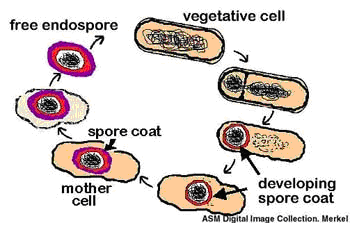Clostridium botulinum is a soil dwelling, heterotrophic bacteria which metabolizes food strictly through fermentation. Like most pathogenic bacteria, specific amino acids are required for growth of C. botulinum. The amino acids it needs include; typtophane, threonine, valine, leucine, isoleucine, methionine, argininie, phenylalanine, and tyrosine. When the right amino acid is available, and conditions are right, energy gained from fermentation is used in reproduction via binary fission. Conversely, when conditions are bad, Clostridium botulinum uses its energy to produce an endospore, which is strongly resistant to temperature changes.
Interestingly enough, C. botulinum is considered to be an opportunistic pathogenic bacterium as well. Once inside an ideal environment, such as an infants’ intestinal tract, the bacteria gather nutrients any way they can. This in turns leads to more replication inside the host.
The formation of an endospore is shown below.

Now that we have a general overview of the organism, it's time to see what damage it can actually do. Check out what this microscopic organism can do to humans on the Botulism page.